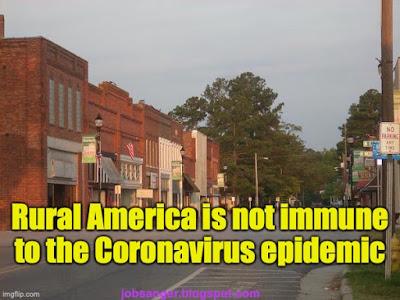 The governors of several mainly rural states have refused to issue stay-at-home orders and closed non-essential businesses. Donald Trump has said that several states may be ready to reopen for business even before his ridiculous May 1st date. And some right-wing websites and groups say the nation should reopen in many places.
The governors of several mainly rural states have refused to issue stay-at-home orders and closed non-essential businesses. Donald Trump has said that several states may be ready to reopen for business even before his ridiculous May 1st date. And some right-wing websites and groups say the nation should reopen in many places.The idea behind that is that rural settings in many states, because the virus has been slow in coming there, will not experience the pain that other areas have had to endure. That they are somehow immune to the Coronavirus epidemic in this country. That is shortsighted and wrong! And it could cause rural communities, many of which already have inadequate hospital facilities, to become sitting ducks for the virus.
The following is part of an article by Megan McArdle in The Washington Post about the danger the virus poses to rural America.
There is something to the rural exceptionalism story, some reason to believe that covid-19 might spread more slowly in rural areas than it does in dense cities. People who live in large, well-ventilated homes with more than one room per person, shop in airy grocery stores with mile-wide lanes, and drive to work in a private vehicle rather than crowding onto public transit with hundreds of strangers might well have fewer opportunities for exposure than your typical New Yorker does.
That said, a slow-motion disaster is still a disaster. And human beings are geniuses at inventing false reasons to feel secure.
At every stage of this pandemic, people have come up with dozens of plausible reasons that the areas overwhelmed by covid-19 were different from their own, happily still secure neighborhoods: more air pollution or smokers, more mass transit or elevators, more cheek-kissing or multi-generational homes. Then as the virus moved on, they came up with reasons that that new place, too, was full of people who are Not Like Us.
Some of those reasons were no doubt true. They just weren’t true enough. It turns out that as long as you have human lungs, the virus likes your flavor just fine, no matter where you live. And unless we take strenuous measures to stop it, eventually the virus will spread to where you live and do its best to kill you.
While rural areas may not have a mass transit system for the virus to move through, they have plenty of churches, high school football games and Rotary pancake breakfasts. As we have already seen, without lockdowns, those can do the job just fine. South Dakota, Nebraska and Arkansas, three states that had looked relatively immune, are all now dealing with serious outbreaks.
In fact, rural areas have some distinct disadvantages compared with big cities. In the large cities where covid-19 first took hold, it took the handful of initial cases months to double and redouble until the sheer number of infections started to overwhelm hospitals. But in a county of 20,000, a disease that is doubling every three to five days would take less than two months to infect 100 percent of the population. By the time doctors even recognized that the disease had arrived in the area, it might well already be too late to stop the disaster.
Those areas don’t have so many of the professional jobs that allow people to work from home, so once the disease does get going, it will be very hard to stamp out. . . .
The hospital systems in rural areas have nothing like the capacity they would need to cope with that sort of outbreak on a wider scale. More than half of all counties in the United States have no intensive care beds. Yet the citizens of those counties tend to be older and sicker than people in urban areas, meaning that if they contract covid-19, they are more likely to need intensive care.
So one can tell a very different story about the nationwide lockdowns, almost the opposite of the one in which less dense areas are being forced to #canceleverything in order to protect New York. In that story, New York’s experience is protecting them by serving as an early warning while they still have time to avoid that city’s fate — or possibly an even worse one — by shutting down now, and then building up the test-trace-quarantine infrastructure that can keep their region covid-free even when restrictions are lifted.
But for this story to have its happy ending, they’ll have to abandon that other narrative and face the unpleasant reality that New Yorkers have belatedly acknowledged: No person or place is really that different from you, and no law of nature will keep this virus in far-off places, killing people you’ve never met.

